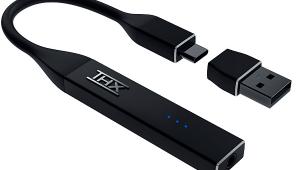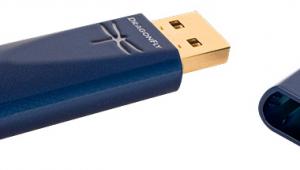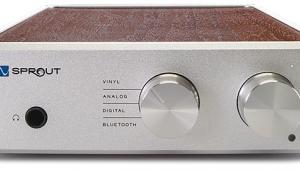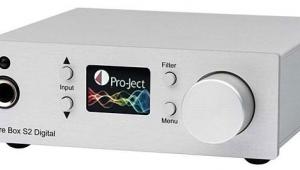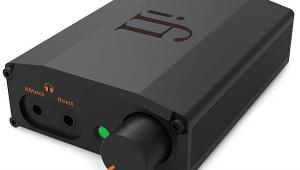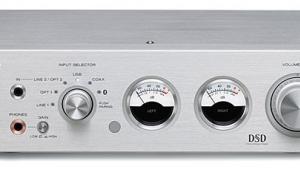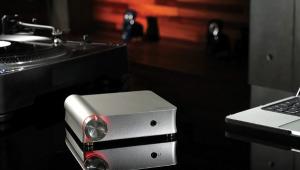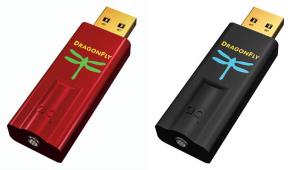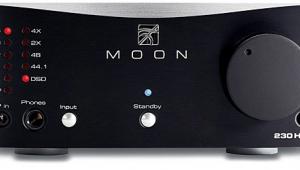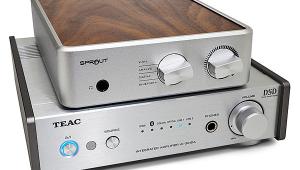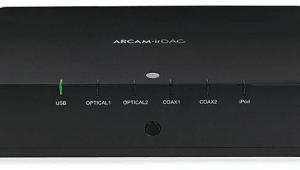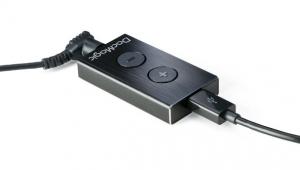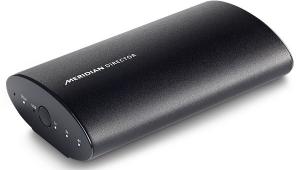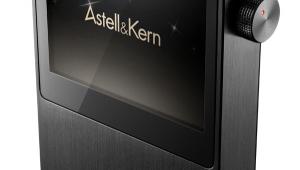Review: FiiO E17 and ADL Stride Portable Headphone Amplifiers Page 3
Alpha Design Labs Stride
Furutech's Alpha Design Labs (ADL) line was developed by the well-respected connector, cable, and turntable accessory manufacturer as an outlet for affordable audio electronics, wired using Furutech's premium cabling and connectors. The $399 Stride USB DAC/headphone amp is the lowest-priced of the four products unveiled so far - the Cruise, the Stride's carbon-fiber-wrapped bigger brother, and the GT40 and Esprit desktop DAC/preamp combo units.
The minimalist unit is, like the Cruise, packaged in a wedge-shaped case, with rounded edges, the overall effect being vaguely reminiscent of an extruded shark's fin. It's a little odd looking, though the ergonomics are actually quite well thought out, so long as you plan to hold the unit in your hand. There's enough heft that you won't drop it, but then again it's a bit big to strap to an iPod or phone so you'll likely end up pocketing it. Controls and I/O are on the endpanels, making for convenient use with a portable. The provided soft case has room for both devices for on-the-move use. Both devices use the same 24/96-capable USB decoder, and offer an 1/8-inch line input for use with a portable device - these are straightforward, to the point devices.
ADL claims a battery life of up to 80 hours - I wasn't able to push the little thing to such extremes, but practically it should keep up with any portable player you might be using, even a long-lived fresh-out-of-the-box iPod Classic (though I'd imagine you're not going to be going 40 playback hours or more between charges in any case, unless you're deep in the backcountry, in which case you probably should take your headphones off once in a while anyway). Still, the runtime is there if you want and need it, and for a portable amp that's an uncommon attribute.
Swapping back and forth between the Stride and the E17 with the same range of program material (the aforementioned Beethoven, Roxy Music, Oval, and Miles Davis tracks, among many others), I did find myself ever-so-slightly preferring the minimalist Stride over the E17 - but frankly, I could easily attribute that to the Stride's thumbwheel, which made getting just the right volume setting a tad simpler than the E17's stepped digital volume control buttons. These sorts of ergonomic considerations are important, especially given the small differences in audio perfomance betwen devices these days, the state of the art being as high as it is. Does it offset the possible ergonomic downside of the wedge shape? That's in the hand of the beholder.
The Stride, of course, is quite a bit more limited in functionality than the FiiO E17 is, even on its own. There's no line out here for desktop use, for instance, though if you want to use the Stride as a standalone USB DAC, it's transparent enough that you could always crank up the little box's volume control (treating the headphone amp as an ad hoc line stage) and patch it on over via a 1/8-inch-to-1/8-inch cable to the external amp (or powered speaker pair) of your choice. Not being content to muse, I gave this a shot with the various potential victims I had lying around, namely the FiiO E9 and the CEntrance DACmini (look out soon for our take on CEntrance's desktop system). It works perfectly well in that application, and while such a kludge might not be audiophile approved, it'll do in a pinch.
The ADL costs three times what the E17 does, and - as you can guess from looking at the front and rear panels - doesn't do anywhere near as much. You could pick up the E17, the E9, and a whole host of accessories from FiiO, be prepared for any headphone listening eventuality, and still come out ahead.
Still, I did find myself coming back to the Stride, and really found myself wishing for an analog volume control whenever I switched over to the E17. And not having a ton of bells and whistles on a device means you don't have to deal with those if you don't want to - with the Stride, when you switch headphones and need more power, you can just turn up the thumbwheel; on the E17 you might need a couple of back and forth trips between the gain submenu and the volume control. Not a showstopper, but sometimes simplicity is best. Whether it's worth paying a premium for it is up to you.
- Log in or register to post comments
